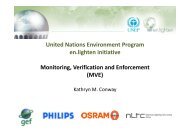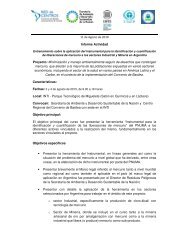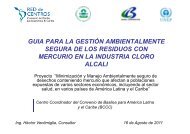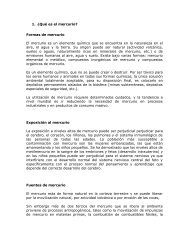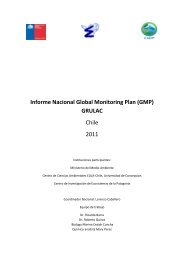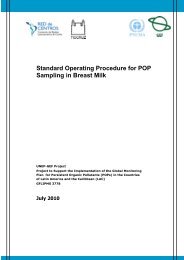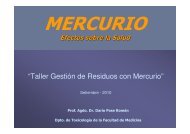Report on Global Monitoring Project Pesticide Research Laboratory ...
Report on Global Monitoring Project Pesticide Research Laboratory ...
Report on Global Monitoring Project Pesticide Research Laboratory ...
You also want an ePaper? Increase the reach of your titles
YUMPU automatically turns print PDFs into web optimized ePapers that Google loves.
<str<strong>on</strong>g>Report</str<strong>on</strong>g> <strong>on</strong> <strong>Global</strong> M<strong>on</strong>itoring <strong>Project</strong><br />
<strong>Pesticide</strong> <strong>Research</strong> <strong>Laboratory</strong>, University of the<br />
West Indies, Jamaica.<br />
<strong>Project</strong> Title: Supporting the Implementati<strong>on</strong> of the <strong>Global</strong><br />
M<strong>on</strong>itoring Plan of POPs in Latin America and Caribbean<br />
States (LAC).<br />
Survey of Human Milk and Air Samples for Residual<br />
Persistent Organic Pollutants<br />
UNEP-GEF<br />
September 2011<br />
COORDINATOR: Professor Tara P. Dasgupta<br />
<strong>Pesticide</strong> <strong>Research</strong> <strong>Laboratory</strong><br />
Department of Chemistry<br />
University of the West Indies, M<strong>on</strong>a<br />
Kingst<strong>on</strong> 7, Jamaica.
Abstract<br />
Human milk samples from 50 first-time mothers were analyzed for POPs. Milk samples were<br />
collected from mothers living in rural and urban Jamaica in order to provide a representati<strong>on</strong> of<br />
the country‟s populati<strong>on</strong>. Air sample m<strong>on</strong>itoring was d<strong>on</strong>e using polyurethane foams (PUFs)<br />
c<strong>on</strong>tained in eight (8) passive air samplers located in <strong>on</strong>e fixed area in the heart of the Kingst<strong>on</strong><br />
city. The exposures of the PUFs were d<strong>on</strong>e in four (4) rounds between August 26, 2010 and July<br />
8, 2011 (see details in table 1 below). There were eight (8) PUF samples per round, four (4) of<br />
which were analysed for Persistent Organic Pollutants (POPs), dioxins and furans by the<br />
designated local laboratory (<strong>Pesticide</strong> <strong>Research</strong> <strong>Laboratory</strong>, PRL) and the other four (4) samples<br />
were analysed by a designated laboratory in Spain for the same parameters. The Standard<br />
Operating Procedure (SOP) used for the analysis of the PUF samples and the results are shown<br />
secti<strong>on</strong> 2 and 3 respectively.
Preamble:<br />
The titled project was initiated by the Regi<strong>on</strong>al Center of the Stockholm C<strong>on</strong>venti<strong>on</strong> Latin<br />
America and the Caribbean (SCU), Laboratorio Tecnológico del Uruguay (LATU), M<strong>on</strong>tevideo,<br />
Uruguay. The financial support for the project was obtained from GEF/UNEP. A Memorándum<br />
of Understanding (MOU) between the <strong>Pesticide</strong> <strong>Research</strong> <strong>Laboratory</strong> (PRL) , University of the<br />
West Indies (UWI), Jamiaca and LATU was formally established in 2010 to strengthen the<br />
nati<strong>on</strong>al m<strong>on</strong>itoring capacity, to build regi<strong>on</strong>al testing capacities and to develop data <strong>on</strong> POPs to<br />
be incorporated in the global report for the C<strong>on</strong>ference of the Parties of the Stockholm<br />
C<strong>on</strong>venti<strong>on</strong>.<br />
Introducti<strong>on</strong>:<br />
The Governing Council of UNEP decided in May 1995 to begin investigating POPs. Initially a<br />
short list of the following twelve POPs known as „Dirty Doz<strong>on</strong>” was made to begin<br />
investigati<strong>on</strong>:<br />
Aldrin, chlordane, DDT, dieldrin, endrin, heptachlor, hexachlorobenzene, mirex,polychlorinated<br />
biphenyls, polychlorinated dibenzo-p-dioxins, polychlorinated dibenzofurans, and toxaphene.<br />
These compounds are halogenated aromatic compounds that are widespread and persistent<br />
envir<strong>on</strong>mental pollutants (1).<br />
POPs have three chemical characteristics that make them<br />
intrinsically hazardous: they are stable (persistent), they are fat-seeking, and they have the<br />
potential to act as endocrine disruptors (2).<br />
The highly lipophilic and hydrophobic PCBs, dioxins (PCDDs and PCDFs), and related<br />
compounds tend to partiti<strong>on</strong> into soil and sediment, bioc<strong>on</strong>centrate from water to aquatic animal,<br />
and biomagnify up the multistep food chain (3). Humans are also high <strong>on</strong> the food chain, eating<br />
meat and dairy products from herbivores, as well as fish and plants (4). More than 90% of the<br />
total daily human exposure to PCBs and dioxins is made up of oral intake from food, whereas<br />
other routes, e.g., water, air and soil, c<strong>on</strong>tribute to less than 10% of total exposure (4)<br />
The human fetus is exposed to PCBs and dioxins through placental transport, and higher<br />
quantities of these compounds are transferred to the infant during breast-feeding. The<br />
c<strong>on</strong>centrati<strong>on</strong> of these compounds in breast milk is dependent <strong>on</strong> the maternal PCB and dioxin<br />
body burden (5). This body burden is the result of accumulati<strong>on</strong> of PCBs and dioxins over many<br />
years, especially in fat tissue, combined with the low metabolic degradati<strong>on</strong> and rate of excreti<strong>on</strong><br />
(1).
Follow-up studies performed in children of women accidentally exposed to high levels of PCBs<br />
and related compounds (Japanese and Taiwanese rice oil incidents) have dem<strong>on</strong>strated a variety<br />
of health effects, e.g., lower birth weight, hyper pigmentati<strong>on</strong>, c<strong>on</strong>junctivitis, nail changes, and<br />
developmental delay; these are similar to toxic effects reported in animal studies (5, 6).<br />
Newborns of mothers who reported c<strong>on</strong>sumpti<strong>on</strong> of PCB-c<strong>on</strong>taminated fish from Lake Michigan<br />
showed lower birth weight (7) and lower IQ scores at school-age (8).<br />
In Jamaica there is widespread applicati<strong>on</strong> of PCB and hence the risk or health hazards may be<br />
just as comm<strong>on</strong>. For example, in Jamaica, areas of transformer oil storage or transformer<br />
explosi<strong>on</strong>, PCBs, has been detected in soil samples at c<strong>on</strong>centrati<strong>on</strong>s of 4.8 mg/kg and 8.7mg/kg<br />
respectively (9). However the health effects of exposure to PCBs and related compounds have<br />
not been explored. More importantly the cumulative effects of POPs <strong>on</strong> infants from breast milk<br />
from exposed mothers have not been investigated. The WHO has recently recommended<br />
exclusive breastfeeding up to six m<strong>on</strong>ths of life to achieve optimal growth, development and<br />
health (WHO) (10). Infants who are exclusively breastfed for six m<strong>on</strong>ths, experience less<br />
morbidity from pneum<strong>on</strong>ia and gastrointestinal morbidity than those who are partially breastfed<br />
or not breastfed (11), and no l<strong>on</strong>g term deficits have been dem<strong>on</strong>strated in growth am<strong>on</strong>g infants<br />
from either developing or developed countries who are exclusively breastfed for six m<strong>on</strong>ths or<br />
l<strong>on</strong>ger (12).Additi<strong>on</strong>ally breastfeeding is cheaper, is associated with significantly higher mental<br />
development scores than formula-fed infants . However the effect of sustained c<strong>on</strong>sumpti<strong>on</strong> of<br />
breast milk c<strong>on</strong>taminated with envir<strong>on</strong>mental toxins such as POP‟s <strong>on</strong> infants growth and mental<br />
development is unclear.<br />
More importantly the cumulative levels of POPs in human breast milk have not been<br />
investigated. It is hence necessary, that we seek to measure the levels of the POPs that maybe<br />
present in breast milk, thus providing informati<strong>on</strong> for policy makers to embark <strong>on</strong> crucial plan of<br />
acti<strong>on</strong>s to minimize exposure and/or emissi<strong>on</strong>s of these toxins.
Methodology<br />
The survey included collecting human milk samples from 50 first-time mothers whose milk<br />
samples were analyzed for POPs. Milk samples were collected from mothers living in rural and<br />
urban Jamaica in order to provide a representati<strong>on</strong> of the country‟s populati<strong>on</strong>. Informed c<strong>on</strong>sent<br />
were obtained from the mothers who satisfied the specified eligibility criteria which included age<br />
2. Expressing milk for testing may cause harm to mother and might reduce fertility this<br />
suspici<strong>on</strong> was not limited to breast milk but testing of all bodily fluids.<br />
There was generally also a high level of apprehensi<strong>on</strong> from the mothers even after they were<br />
briefed by the nurses in charge at the clinic. Home visits were arranged for the mother who were<br />
unable to attend the clinic.<br />
There were also various challenges am<strong>on</strong>g those who participated in the survey. These problems<br />
included:<br />
1. Participants who took the samples bottles home them decided that expressing was too<br />
much of a burden and could not c<strong>on</strong>tinue.<br />
2. Participants would agree to participate but would later disc<strong>on</strong>tinue as an older relative<br />
usually the participant‟s mother or grandmother would discourage the mother citing<br />
reas<strong>on</strong>s relating to superstitious belief.<br />
3. Some participants after agreeing for the samples to be collected at home, would then<br />
leave the home for some unknown locati<strong>on</strong> and then could not located or c<strong>on</strong>tacted.<br />
Sample collecti<strong>on</strong> occurred from mid November 2010 to the first week in January of 2011.<br />
Sample classificati<strong>on</strong> was d<strong>on</strong>e as described in Table 1 below.<br />
Locati<strong>on</strong>/ Descripti<strong>on</strong> of<br />
Pool<br />
Table 1: Sample Classificati<strong>on</strong><br />
Number of samples<br />
Pool<br />
number/individual<br />
samples<br />
Rural mother 11 11<br />
Vegetarian 1 1<br />
Smoking/exposed to<br />
2 2<br />
smoke<br />
Older mothers 14 1<br />
Teen mothers 18 1<br />
Sec<strong>on</strong>d time mothers 3 1<br />
Fish eater 1 1<br />
Inner city mothers 15 1<br />
Uptown mothers 3 1<br />
Composite sample 1 1<br />
Total 21
Training Programme:<br />
All samples were analyzed by our trained analysts. However, UNEP arranged to send two<br />
experts from Spain, Drs. Benin and Encara to visit our laboratory and trained two of our analysts,<br />
Dr. Raym<strong>on</strong>d Reid and Ms. Sherin Whyte, <strong>on</strong> the applicati<strong>on</strong> of GC/MS method to detect trace<br />
amount of POPs and PCBs in breast milk and air samples. The training was quite helpful for the<br />
analysts.<br />
Analytical Support:<br />
Initially it was promised by the Regi<strong>on</strong>al coordinator and UNEP that all the glassware and<br />
chemicals will be sent by the UNEP and accordingly a list of requirements was sent to the<br />
UNEP. Unfortunately, except GC column and sample bottles no other items were arrived. It<br />
caused an enormous delay in starting the project and also because of shortage of glassware,<br />
specifically Soxhlet apparatus for extracti<strong>on</strong> of POPs the analyses took us l<strong>on</strong>ger time than<br />
anticipated.<br />
Air Sample (PUFs) 2010-2011<br />
Secti<strong>on</strong> 1<br />
Air sample m<strong>on</strong>itoring was d<strong>on</strong>e using polyurethane foams (PUF). The exposures of the PUFs<br />
were d<strong>on</strong>e in four (4) rounds between August 26, 2010 and July 8, 2011 (see details in table 1<br />
below). There were eight (8) PUF samples per round, four (4) of which were analysed for<br />
Persistent Organic Pollutants (POPs), dioxins and furans by the designated local laboratory<br />
(<strong>Pesticide</strong> <strong>Research</strong> <strong>Laboratory</strong>, PRL) and the other four (4) samples were analysed by a<br />
designated laboratory in Spain for the same parameters. The Standard Operating Procedure<br />
(SOP) used for the analysis of the PUF samples and the results are shown secti<strong>on</strong> 2 and 3<br />
respectively.
Table 1<br />
Installati<strong>on</strong> date<br />
**August 26,<br />
2010<br />
Sampling<br />
Time<br />
Round<br />
Number<br />
PUF samples<br />
analysed by<br />
Spain<br />
PUF samples<br />
analysed by<br />
PRL<br />
9:24 am 1 1, 2, 5 and 7 3, 4, 6, 8 and (the<br />
“reserve” was<br />
analysed by<br />
Bennin)<br />
October 1, 2010 12:20 pm – 12:57<br />
pm<br />
2 1, 2, 5 and 6 3, 4, 7, 8 and<br />
“reserve”<br />
January 3, 2011 5:26 pm – 6:02 pm 3 1, 2, 5 and 6 3, 4, 7, 8 and<br />
“reserve”<br />
April 8, 2011 3:45 pm – 4:30 pm 4 1, 2, 5 and 6 3, 4, 7, 8 and<br />
“reserve”<br />
** Due to late arrival of the PUFs from Spain, the first exposure of the PUFs was not d<strong>on</strong>e as<br />
proposed. (The proposed date was July 1, 2010). So, the first round of samples was <strong>on</strong>ly<br />
exposed for <strong>on</strong>e (1) m<strong>on</strong>th instead of three (3) m<strong>on</strong>ths.<br />
The final round of PUF exposure ended <strong>on</strong> July 8, 2011 between 3:30 pm and 3:45 pm .<br />
Secti<strong>on</strong> 2<br />
Standard Operating Procedure (SOP) for the extracti<strong>on</strong> of PUF sample by the Soxhlet<br />
Method<br />
A pair of clean scissors was used to cut the PUF into small pieces (about 1 cm 2 ) which then<br />
placed into the Soxhlet Apparatus (no thimble was used) with the aid of a pair of tweezers and a<br />
glass stirring rod.<br />
About 200 mL of toluene were added to a 500 mL round bottom flask. (This amount of toluene<br />
was added so that when the extracti<strong>on</strong> tube was filled to the siph<strong>on</strong> point, there was enough<br />
solvent left in the flask to prevent cracking due to heating). The extracti<strong>on</strong> apparatus was<br />
assembled, the round bottom flask positi<strong>on</strong>ed in the heating mantle and the water flow started<br />
through the c<strong>on</strong>denser. The apparatus was supported using a clamp and stand. The heat was<br />
adjusted for at least six cycles per hour. (The cycle is the filling of the extracti<strong>on</strong> tube with<br />
solvent which evaporates from the flask and then c<strong>on</strong>denses into the tube, followed by siph<strong>on</strong>ing<br />
of solvent back into the flask). The sample was extracted for ten (10) hours. The extract was<br />
c<strong>on</strong>centrated to about 1 mL using a rotary evaporator. The 1 mL of evaporated sample extract<br />
was transferred to a florisil column which was prepared as follows: 25 cm x 1 cm glass column<br />
(with a Tefl<strong>on</strong> stopcock and 250 mL reservoir) was plugged with 2 cm glass wool, filled with
hexane and then, 6 g of activated florisil was poured into the column (Florisil 60-100 mesh from<br />
FISCHER, activated overnight at 130C). A gentle shaking of the column was necessary to settle<br />
the florisil inside the column. Two cm of sodium sulphate was then added <strong>on</strong> top. Hexane was<br />
poured into the column and when the hexane reaches the top of the filling, the stopcock was<br />
closed, a 250 mL round bottom flask was placed under the column and the evaporated sample<br />
extract was transferred to the top of the column using a Pasteur pipette. As the sample passes<br />
through the column, the sample c<strong>on</strong>tainer was rinsed with 3 x 2 mL porti<strong>on</strong>s of hexane (from a<br />
premeasured 50 mL of hexane) and rinses were also transferred to the column. The remaining<br />
hexane was poured into the reservoir of the column and the eluti<strong>on</strong> of fracti<strong>on</strong> 1 was performed<br />
at a steady drip of 3 mL/min. When the hexane reached the top of the filling, the stopcock was<br />
turned off, the flask with fracti<strong>on</strong> 1 was replaced with another 250 mL flask, the column was<br />
eluted with 50 mL of 15% DCM/Hexane (v/v) and fracti<strong>on</strong> 2 was collected. The procedure was<br />
then repeated for fracti<strong>on</strong> 3 using 150 mL of 60% DCM/Hexane (v/v). Each of the 3 fracti<strong>on</strong>s<br />
was separately rotary-evaporated (after adding 5 mL of iso-octane – Optima grade) to 1.0 mL. 1<br />
uL of the extract was analysed by a Agilent 6890 GC-MS (scan mode) fitted with a HP 5MS<br />
column (0.25mm x 0.25 um x 30m), the appropriate reference standards and the Chem-Stati<strong>on</strong><br />
Software.<br />
Analysis of Mirror Samples<br />
Fish and Cow‟s Milk samples were collected and each <strong>on</strong>e was splitted to two –A and B. Fish<br />
sample A and Cow‟s Milk sample A were sent to Dr. Estaben‟s <strong>Laboratory</strong> in Spain. B-samples<br />
were analyzed at he <strong>Pesticide</strong> <strong>Research</strong> <strong>Laboratory</strong>.<br />
Mirror Samples:<br />
Results for UNEP Mirror Samples<br />
PCB<br />
C<strong>on</strong>geners<br />
Fish/(ng/kg) Cow’s<br />
Milk/(ng/kg)<br />
PCB18 38.5 nd<br />
PCB17 17 nd<br />
PCB31 110.8 nd
PCB28 nd nd<br />
PCB33 36.7 nd<br />
PCB52 91.9 nd<br />
PCB49 145.4 nd<br />
PCB44 43.5 nd<br />
PCB74 53.5 nd<br />
PCB70+76 64 nd<br />
PCB66+95 112.4 nd<br />
PCB101 86.9 nd<br />
PCB99 49.5 nd<br />
PCB87 190.4 nd<br />
PCB110 66.5 nd<br />
PCB151+182 nd nd<br />
PCB149 29.3 nd<br />
PCB118 89.7 nd<br />
PCB<br />
C<strong>on</strong>geners<br />
Fish/(ng/kg) Cow’s<br />
Milk/(ng/kg)<br />
PCB153 184.3 24.1<br />
PCB105+132 45.8 nd<br />
PCB138 79.8 nd<br />
PCB158 69.3 nd<br />
PCB187 105.9 nd<br />
PCB183 66.5 nd<br />
PCB128 44.9 nd<br />
PCB173 77 nd<br />
PCB156+171 49.1 nd<br />
PCB180 76.7 14.2<br />
PCB191 nd nd<br />
PCB169 nd nd<br />
PCB170+190 95.3 nd<br />
PCB201 nd nd<br />
PCB195+208 nd nd<br />
PCB194 46 nd<br />
PCB205 nd nd<br />
PCB206 nd nd<br />
PCB209 nd nd<br />
<strong>Pesticide</strong>s Fish/(ng/kg) Cow’s<br />
Milk/(ng/kg)<br />
a-BHC 59.3 nd<br />
HCB 71 nd<br />
B-BHC nd nd<br />
g-BHC 144.5 nd<br />
d-BHC 36.8 nd<br />
Heptachlor 40.5 nd
Aldrin 25.6 12.9<br />
Endosulfan I 79.4 nd<br />
Oxychlordane + Heptachlor epoxide A 53.5 nd<br />
Heptachlor Epoxide B 64 nd<br />
trans-chlordane 232 nd<br />
o,p'-DDE nd nd<br />
cis-chlordane 210.1 nd<br />
p,p'-DDE 190.4 nd<br />
dieldrin nd nd<br />
o,p'-DDD 51.7 nd<br />
Endrin 32.5 nd<br />
endsulfan II 89.7 nd<br />
p,p'-DDD 42.3 nd<br />
o,p'-DDT 46.5 nd<br />
p,p'-DDT 65.2 nd<br />
methoxychlor 85.1 nd<br />
mirex nd nd<br />
nd – not detected (detecti<strong>on</strong> is less than 10 µg/L)<br />
UNEP PUF Results_Rounds #1&2_B<br />
Matrix<br />
AIR<br />
Date 4/26/2011 9/27/2011<br />
No. 1 2<br />
Sample-ID JAM-1-I JAM-1-II<br />
Country JAMAICA JAMAICA<br />
Fat (%)<br />
Unit ng filter -1 ng filter -1<br />
Aldrin 0.214 0.065<br />
Dieldrin 0.179 0.0004<br />
Endrin 0.014 0.003<br />
Sum drins 0.407 0.068<br />
a-Chlordane 0.0004 0.0004<br />
g-Chlordane 0.115 0.026<br />
Oxychlordane 0.0004 0.0004<br />
cis-N<strong>on</strong>achlor 0.149 0.0004<br />
trans-N<strong>on</strong>achlor 0.0004 0.0004<br />
Sum chlordanes 0.265 0.028<br />
Sum chlordane equivalent
UNEP Inter-calibrati<strong>on</strong> 2010-2011 (Part 1)<br />
UNEP Intercalibrati<strong>on</strong> 2010<br />
Ash Sediment Fish Mothers' Milk<br />
Standard<br />
1 C<br />
Code: (ng/kg) (ng/kg) (µg/kg) (µg/kg) (ng/µl)<br />
Date Received: October 26, 2010<br />
Date Analyzed: January 13-18, 2011<br />
(Wet) Weight received: 9.974g<br />
Lipid weight: * 4.69E+06 5.50E+06 *<br />
% Lipids: * 0.47 0.55 *<br />
Drins<br />
Aldrin * 9.88 10.11<br />
Dieldrin * 10.02 9.98<br />
Endrin * 10.09 10.02<br />
Sum Drins Lower Bound (ND = 0) *<br />
Sum Drins Upper Bound (ND = LOD) *<br />
Notes<br />
* not applicable<br />
All values should be reported in ng/kg or<br />
pg/µl<br />
ND: not detected < than value expected<br />
NA: not analyzed<br />
UNEP Inter-calibrati<strong>on</strong> 2010-2011 (Part 2)<br />
UNEP Intercalibrati<strong>on</strong> 2010<br />
Ash Sediment Fish Mothers' Milk<br />
Standard<br />
1 C<br />
Code: (ng/kg) (ng/kg) (µg/kg) (µg/kg) (ng/µl)<br />
Date Received: October 26, 2010<br />
Date Analyzed: January 13-18, 2011<br />
(Wet) Weight received: 9.974g<br />
Lipid weight: * 4.69E+06 5.50E+06 *<br />
% Lipids: * 0.47 0.55 *<br />
Chlordanes<br />
trans-Chlordane * 10.06 10.14<br />
cis-Chlordane * 10.02 10.12<br />
trans-N<strong>on</strong>achlor * 9.86 10.06<br />
cis-N<strong>on</strong>achlor * 9.92 10.08<br />
Oxychlordane * 10.01 10.01<br />
Heptachlor * 10.04 9.96<br />
cis-Heptachlorepoxide * 10.05 9.87<br />
trans-Heptachlorepoxide * 10 9.82<br />
Sum Chlordane Lower Bound (ND = 0) *<br />
Sum Chlordane Upper Bound (ND = LOD) *<br />
Notes<br />
* not applicable<br />
All values should be reported in ng/kg or pg/µl<br />
ND: not detected < than value expected<br />
NA: not analyzed
UNEP Inter-calibrati<strong>on</strong> 2010-2011 (Part 3)<br />
UNEP Intercalibrati<strong>on</strong> 2010<br />
Ash Sediment Fish Mothers' Milk<br />
Standard 1<br />
C<br />
Code: (ng/kg) (ng/kg) (µg/kg) (µg/kg) (ng/µl)<br />
Date Received: October 26, 2010<br />
Date Analyzed: January 13-18, 2011<br />
(Wet) Weight received: 9.974g<br />
Lipid weight: * 4.69E+06 5.50E+06 *<br />
% Lipids: * 0.47 0.55 *<br />
DDTs<br />
p,p'-DDT * 10.04 10.16<br />
o,p'-DDT * 10.07 10.15<br />
p,p'-DDE * 10.04 10.04<br />
o,p'-DDE * 10.04 10.07<br />
p,p'-DDD * 10.04 9.94<br />
o,p'-DDD * 10.04 10.01<br />
Sum DDTs Lower Bound (ND = 0) *<br />
Sum DDTs Upper Bound (ND = LOD) *<br />
Mirex * 9.92 10.17<br />
Hexachlorobenzene 9.98 10.12<br />
Notes<br />
* not applicable<br />
All values should be reported in ng/kg or pg/µl<br />
ND: not detected < than value expected<br />
NA: not analyzed<br />
UNEP Inter-calibrati<strong>on</strong> 2010-2011 (Part 3)<br />
UNEP Intercalibrati<strong>on</strong> 2010<br />
Ash Sediment Fish Mothers' Milk<br />
Standard 1<br />
C<br />
Code: (ng/kg) (ng/kg) (µg/kg) (µg/kg) (ng/µl)<br />
Date Received: October 26, 2010<br />
Date Analyzed: January 13-18, 2011<br />
(Wet) Weight received: 9.974g<br />
Lipid weight: * 4.69E+06 5.50E+06 *<br />
% Lipids: * 0.47 0.55 *<br />
DDTs<br />
p,p'-DDT * 10.04 10.16<br />
o,p'-DDT * 10.07 10.15<br />
p,p'-DDE * 10.04 10.04<br />
o,p'-DDE * 10.04 10.07<br />
p,p'-DDD * 10.04 9.94<br />
o,p'-DDD * 10.04 10.01<br />
Sum DDTs Lower Bound (ND = 0) *<br />
Sum DDTs Upper Bound (ND = LOD) *<br />
Mirex * 9.92 10.17<br />
Hexachlorobenzene 9.98 10.12<br />
Notes<br />
* not applicable<br />
All values should be reported in ng/kg or pg/µl<br />
ND: not detected < than value expected<br />
NA: not analyzed
UNEP Inter-calibrati<strong>on</strong> 2010-2011 (Part 4)<br />
UNEP Intercalibrati<strong>on</strong> 2010<br />
Ash Sediment Fish Mothers' Milk Standard 1 B<br />
Code: (ng/kg) (ng/kg) (ug/kg) (ug/kg) (ng/µl)<br />
Date Received: October 26, 2010<br />
Date Analyzed: January 14-18, 2011<br />
(Wet) Weight received: 9.974g<br />
Lipid weight: * * 4.69E+06 5.50E+06 *<br />
% Lipids: * * 0.47 0.55 *<br />
Marker PCBs<br />
PCB #28 2.008 2.012<br />
PCB #52 1.984 1.992<br />
PCB #101 2.01 2.018<br />
PCB #118 2.002 2.009<br />
PCB #138 2.016 2.023<br />
PCB #153 1.984 1.998<br />
PCB #180 1.994 2.002<br />
Sum Marker PCB Lower Bound (ND = 0)<br />
Sum Marker PCB Upper Bound (ND = LOD)<br />
Notes<br />
* not applicable<br />
All values should be reported in ng/kg or ng/µl<br />
ND: not detected < than value expected<br />
NA: not analyzed<br />
Basic POPs Results<br />
Sample type: Human milk<br />
Country: Jamaica<br />
Sample no. 11012943<br />
Date: 27/04/11<br />
Lipid c<strong>on</strong>tent [%]: 4.4<br />
Parameter<br />
Aldrin<br />
C<strong>on</strong>centrati<strong>on</strong> g/g lipid weight<br />
nd<br />
Chlordane group 2.7<br />
alpha-chlordane<br />
gamma-chlordane<br />
nd<br />
nd<br />
gamma-chlordane 2.8<br />
Trans-n<strong>on</strong>achlor 4.5<br />
Dieldrin 2.4
Basic POPs Results<br />
Sample type: Human milk<br />
Country: Jamaica<br />
Sample no. 11012943<br />
Date: 27/04/11<br />
Lipid c<strong>on</strong>tent [%]: 4.4<br />
Parameter<br />
Aldrin<br />
C<strong>on</strong>centrati<strong>on</strong> g/g lipid weight<br />
nd<br />
Chlordane group 2.7<br />
alpha-chlordane<br />
gamma-chlordane<br />
nd<br />
nd<br />
gamma-chlordane 2.8<br />
Trans-n<strong>on</strong>achlor 4.5<br />
Dieldrin 2.4<br />
Basic POPs Results (c<strong>on</strong>t’d)<br />
Sample type: Human milk<br />
Country: Jamaica<br />
Sample no. 11012943<br />
Date: 27/04/11<br />
Lipid c<strong>on</strong>tent [%]: 4.4<br />
Parameter<br />
C<strong>on</strong>centrati<strong>on</strong> g/g lipid weight<br />
DDT group 173.0<br />
o,p‟-DDD<br />
p,p‟-DDD<br />
o,p‟-DDE<br />
p,p‟-DDE 147.4<br />
o,p‟-DDT 1.0<br />
p,p‟-DDT 7.7<br />
Endrin group<br />
Endrin<br />
Endrin ket<strong>on</strong>e<br />
nd<br />
nd<br />
nd<br />
nd<br />
nd<br />
nd
Basic POPs Results (c<strong>on</strong>t’d)<br />
Sample type: Human milk<br />
Country: Jamaica<br />
Sample no. 11012943<br />
Date: 27/04/11<br />
Lipid c<strong>on</strong>tent [%]: 4.4<br />
Parameter<br />
Heptachlor group<br />
Heptachlor<br />
Heptachlor-epoxide cis<br />
Heptachlor-epoxide trans<br />
C<strong>on</strong>centrati<strong>on</strong> g/g lipid weight<br />
Hexachlorobenzene 3.5<br />
Hexachlorocyclohexane (HCH) group<br />
alpha-HCH<br />
beta-HCH 1.5<br />
gamma-HCH<br />
nd<br />
nd<br />
nd<br />
nd<br />
nd<br />
nd<br />
Basic POPs Results (c<strong>on</strong>t’d)<br />
Sample type: Human milk<br />
Country: Jamaica<br />
Sample no. 11012943<br />
Date: 27/04/11<br />
Lipid c<strong>on</strong>tent [%]: 4.4<br />
Parameter<br />
C<strong>on</strong>centrati<strong>on</strong> g/g lipid weight<br />
Parlar (toxaphene) group 1.3<br />
Parlar 26 0.5<br />
Parlar 50 0.8<br />
Parlar 62<br />
Mirex<br />
nd<br />
nd<br />
Explanati<strong>on</strong>s: nd = not detected (< 0.5 ng/g fat)<br />
1) sum of alpha-chlordane, beta-chlordane and oxychlordane, calculated as chlordane<br />
2) sum of o,p'-DDT, p,p'-DDT, p,p'-DDE and p,p'-DDD, calculated as DDT<br />
3) sum of endrin and endrin ket<strong>on</strong>e, calculated as endrin<br />
4) sum of heptachlor and heptachlor-epoxid (cis/trans), calculated as heptachlor<br />
5) sum of parlar 26, parlar 50 and parlar 62
PCDD/Fs Results<br />
Sample type: Human Milk<br />
Country: Jamaica<br />
Sample no. 11012943<br />
Date: 27/04/11<br />
Lipid c<strong>on</strong>tent [%]: 4.4<br />
2,3,7,8-substituted PCDF/PCDD<br />
C<strong>on</strong>centrati<strong>on</strong> pg/g lipid weight<br />
2,3,7,8-TCDF 0.417<br />
1,2,3,7,8-PeCDF 0.204<br />
2,3,4,7,8-PeCDF 1.71<br />
1,2,3,4,7,8-HxCDF 1.19<br />
2,3,4,6,7,8-HxCDF 1.16<br />
1,2,3,7,8,9-HxCDF 0.457<br />
1,2,3,4,6,7,8-HpCDF 0.0352<br />
1,2,3,4,7,8,9-HpCDF 2.09<br />
OCDF 0.181 0.109<br />
PCDD/Fs Results (c<strong>on</strong>t’d)<br />
Sample type: Human Milk<br />
Country: Jamaica<br />
Sample no. 11012943<br />
Date: 27/04/11<br />
Lipid c<strong>on</strong>tent [%]: 4.4<br />
2,3,7,8-substituted PCDF/PCDD<br />
C<strong>on</strong>centrati<strong>on</strong> pg/g lipid weight<br />
2,3,7,8-TCDD 0.436<br />
1,2,3,7,8-PeCDD 1.81<br />
1,2,3,4,7,8-HxCDD 1.38<br />
1,2,3,6,7,8-HxCDD 6.74<br />
1,2,3,7,8,9-HxCDD 2.00<br />
1,2,3,4,6,7,8-HpCDD 14.0<br />
OCDD 56.9<br />
Explanati<strong>on</strong>s:<br />
< [LOQ] Below limit of quantificati<strong>on</strong> (LOQ)
PCB Results<br />
Sample type: Human Milk<br />
Country: Jamaica<br />
Sample no. 11012943<br />
Date: 27/04/11<br />
Lipid c<strong>on</strong>tent [%]: 4.4<br />
Indicator PCB<br />
C<strong>on</strong>centrati<strong>on</strong> ng/g lipid weight<br />
PCB 28 0.955<br />
PCB 52 0.317<br />
PCB 101 0.688<br />
PCB 138 7.94<br />
PCB 153 10.1<br />
PCB 180 3.87<br />
Sum Indicator PCB 23.8<br />
PCB Results (c<strong>on</strong>t’d)<br />
Sample type: Human Milk<br />
Country: Jamaica<br />
Sample no. 11012943<br />
Date: 27/04/11<br />
Lipid c<strong>on</strong>tent [%]: 4.4<br />
M<strong>on</strong>o-ortho PCB<br />
C<strong>on</strong>centrati<strong>on</strong> ng/g lipid weight<br />
PCB 105 1.94<br />
PCB 114 0.256<br />
PCB 118 5.75<br />
PCB 123 0.0780<br />
PCB 156 1.54<br />
PCB 157 0.362<br />
PCB 167 0.468<br />
PCB 189 0.0717
PCB Results (c<strong>on</strong>t’d)<br />
Sample type: Human Milk<br />
Country: Jamaica<br />
Sample no. 11012943<br />
Date: 27/04/11<br />
Lipid c<strong>on</strong>tent [%]: 4.4<br />
N<strong>on</strong>-ortho PCB<br />
C<strong>on</strong>centrati<strong>on</strong> ng/g lipid weight<br />
PCB 77 0.00447<br />
PCB 81 0.00174<br />
PCB 126 0.01303<br />
PCB 169 0.00526<br />
Explanati<strong>on</strong>s:<br />
< [LOQ] Below limit of quantificati<strong>on</strong> (LOQ)<br />
UNEP Chemicals Branch "POPs Results <str<strong>on</strong>g>Report</str<strong>on</strong>g>ing Form"<br />
Compound/Indicator UB LB<br />
Matrix AIR AIR AIR AIR<br />
Date 26/04/2011 27/09/2011 26/04/2011 27/09/2011<br />
No 1 2 1 2<br />
Sample ID JAM-1-I JAM-1-II JAM-1-I JAM-1-II<br />
Country JAMAICA JAMAICA JAMAICA JAMAICA<br />
Unit ng filter -1 ng filter -1 ng filter -1 ng filter -1<br />
Basic POPs <strong>Pesticide</strong>s<br />
Sum drins 0.407 0.068 0 0.407 0.068<br />
Sum chlordanes 0.265 0.028 0 0.264 0.026<br />
Sum DDTs 0.176 0.053 0 0.175 0.052<br />
Sum heptachlor 0.063 0.289 0 0.062 0.289<br />
HCB 0.188 0.226 0 0.188 0.226<br />
Mirex 0.022 0.0004 0 0.022 0<br />
Sum toxaphene 0 0 0 0 0<br />
PCB7<br />
Sum PCB7 18.56 19.26 0 18.56 19.26<br />
dl-POPs<br />
WHO1998-TEQPCDD/PCDF 22.93 38.87 0 22.87 38.50<br />
WHO1998-TEQPCB 4.03 4.37 0 4.03 4.37<br />
WHO1998-TEQPCDD/PCDF/PCB 26.96 43.24 0 26.90 42.87
Upper-bound<br />
Please enter NDs with their LOQ<br />
Matrix AIR AIR<br />
Date 26/04/2011 27/09/2011<br />
No. 1 2 3<br />
Correcti<strong>on</strong> factors Sample-ID JAM-1-I JAM-1-II<br />
for OCP<br />
equivalents<br />
Country JAMAICA JAMAICA<br />
Fat (%)<br />
Unit ng filter -1 ng filter -1 ng<br />
filter -1<br />
Aldrin 0.214 0.065<br />
Dieldrin 0.179 0.0004<br />
Endrin 0.014 0.003<br />
UB Sum drins 0.407 0.068 0.0<br />
1 -Chlordane 0.0004 0.0004<br />
1 -Chlordane 0.115 0.026<br />
0.967 Oxychlordane 0.0004 0.0004<br />
0.923 cis-N<strong>on</strong>achlor 0.149 0.0004<br />
0.923 trans-N<strong>on</strong>achlor 0.0004 0.0004<br />
UB Sum chlordanes 0.265 0.028 0.0<br />
1 o,p'-DDT 0.021 0.017<br />
1 p,p'-DDT 0.068 0.0004<br />
1.108 o,p'-DDD 0.0004 0.0004<br />
1.108 p,p'-DDD 0.007 0.015<br />
1.115 o,p'-DDE 0.0004 0.0004<br />
1.115 p,p'-DDE 0.079 0.020<br />
UB Sum DDTs 0.176 0.053 0.0<br />
1 Heptachlor 0.062 0.255<br />
0.959 cis-Heptachlorepoxide 0.0004 0.0004<br />
0.959 trans-Heptachlorepoxide 0.0004 0.034<br />
UB Sum heptachlor 0.063 0.289 0.0<br />
UB HCB 0.188 0.226<br />
UB Mirex 0.022 0.0004<br />
Parlar 26<br />
Parlar 50<br />
Parlar 62<br />
UB Sum toxaphene 0 0 0
-HCH 0.009 0.053<br />
-HCH 0.044 0.0004<br />
-HCH 0.0004 0.030<br />
Matrix AIR AIR 0<br />
No 1 2<br />
Sample ID JAM-1-I JAM-1-II<br />
Unit ng filter -1 ng filter -1 ng<br />
filter -1<br />
UB Sum drins 0.41 0.1 0.0<br />
LB Sum drins 0.407 0.068 0<br />
Difference 0% 1% #DIV/0!<br />
UB Sum chlordanes 0.27 0.0 0.0<br />
LB Sum chlordanes 0.264 0.026 0<br />
Difference 0% 6% #DIV/0!<br />
UB Sum DDTs 0.2 0.1 0.0<br />
LB Sum DDTs 0.175 0.052 0<br />
Difference 0% 2% #DIV/0!<br />
UB Sum heptachlor 0.1 0.3 0.0<br />
LB Sum heptachlor 0.062 0.289 0<br />
Difference 1% 0% #DIV/0!<br />
UB HCB 0.2 0.2 0.0<br />
LB HCB 0.188 0.226 0<br />
Difference 0% 0% #DIV/0!<br />
UB Mirex 0.0 0.0 0.0<br />
LB Mirex 0.022 0 0<br />
Difference 0% 100% #DIV/0!<br />
UB Sum toxaphene 0.0 0.0 0.0<br />
LB Sum toxaphene 0 0 0<br />
Difference #DIV/0! #DIV/0! #DIV/0!<br />
Lower-bound Please enter NDs with 0<br />
Matrix AIR AIR<br />
Date 26/04/2011 27/09/2011<br />
No. 1 2 3<br />
Correcti<strong>on</strong> factors Sample-ID JAM-1-I JAM-1-II<br />
for OCP<br />
equivalents<br />
Country JAMAICA JAMAICA<br />
Fat (%)<br />
Unit ng filter -1 ng filter -1 ng<br />
filter -1
Aldrin 0.214 0.065<br />
Dieldrin 0.179 0<br />
Endrin 0.014 0.003<br />
LB Sum drins 0.407 0.068 0.0<br />
1 -Chlordane 0 0<br />
1 -Chlordane 0.115 0.026<br />
0.967 Oxychlordane 0 0<br />
0.923 cis-N<strong>on</strong>achlor 0.149 0<br />
0.923 trans-N<strong>on</strong>achlor 0 0<br />
LB Sum chlordanes 0.264 0.026 0.0<br />
1 o,p'-DDT 0.021 0.017<br />
1 p,p'-DDT 0.068 0<br />
1.108 o,p'-DDD 0 0<br />
1.108 p,p'-DDD 0.007 0.015<br />
1.115 o,p'-DDE 0 0<br />
1.115 p,p'-DDE 0.079 0.020<br />
LB Sum DDTs 0.175 0.052 0.0<br />
1 Heptachlor 0.062 0.255<br />
0.959 cis-Heptachlorepoxide 0 0<br />
0.959 trans-Heptachlorepoxide 0 0.034<br />
LB Sum heptachlor 0.062 0.289 0.0<br />
LB HCB 0.188 0.226<br />
LB Mirex 0.022 0<br />
Parlar 26<br />
Parlar 50<br />
Parlar 62<br />
LB Sum toxaphene 0 0 0
Upper-bound<br />
Please enter NDs with their LOQ<br />
Matrix Air Air<br />
Date 26/04/2011 27/09/2011<br />
No. 1 2 3<br />
Sample-ID JAM-2-I JAM-2-II<br />
Country JAMAICA JAMAICA<br />
Fat (%) -<br />
Unit ng filter -1 ng filter -1 ng filter -1<br />
UB<br />
PCB #28 6.20 6.51<br />
PCB #52 4.26 4.46<br />
PCB #101 2.55 2.51<br />
PCB #118 1.34 1.34<br />
PCB #138 1.49 2.29<br />
PCB #153 2.16 1.36<br />
PCB #180 0.560 0.794<br />
Sum PCB 7 18.56 19.26 0.00<br />
ng filter -1 ng filter -1 ng filter -1<br />
UB Sum PCB7 18.56 19.26 0<br />
LB Sum PCB7 18.56 19.26 0<br />
Difference 0% 0% #DIV/0!<br />
PCB-105 0.0760<br />
PCB-156 0.0206<br />
Lowerbound<br />
Please enter NDs with 0<br />
Matrix Air Air<br />
Date 26/04/2011 27/09/2011<br />
No. 1 2 3<br />
Sample-ID JAM-2-I JAM-2-II<br />
Country JAMAICA JAMAICA<br />
Fat (%) -<br />
Unit ng filter -1 ng filter -1 ng filter -1<br />
LB<br />
PCB #28 6.20 6.51<br />
PCB #52 4.26 4.46<br />
PCB #101 2.55 2.51<br />
PCB #118 1.34 1.34<br />
PCB #138 1.49 2.29<br />
PCB #153 2.16 1.36<br />
PCB #180 0.560 0.794<br />
Sum PCB 7 18.56 19.26 0.00
Upper-bound<br />
WHO 1998 -TEF<br />
Please enter NDs with their LOQ<br />
Matrix Air Air<br />
Date 26/04/2011 27/09/2011<br />
No. 1 2 3<br />
Sample-ID JAM-7-I JAM-7-II<br />
Country JAMAICA JAMAICA<br />
Fat (%)<br />
Unit pg filter -1 pg filter -1 ng filter -<br />
PCDD/PCDF<br />
1 2378-Cl 4 DD<br />
1.75 3.77<br />
1 12378-Cl 5 DD 9.03 14.20<br />
0.1 123478-Cl 6 DD<br />
5.98 7.74<br />
0.1 123678-Cl 6 DD 11.24 16.56<br />
0.1 123789-Cl 6 DD 10.06 14.51<br />
0.01 1234678-Cl 7 DD<br />
88.08 128.65<br />
0.0001 Cl 8 DD 362.82 573.68<br />
0.1 2378-Cl 4 DF<br />
7.34 16.36<br />
0.05 12378-Cl 5 DF 0.101 0.196<br />
0.5 23478-Cl 5 DF<br />
8.94 17.93<br />
0.1 123478-Cl 6 DF 8.17 12.10<br />
0.1 123678-Cl 6 DF 10.22 14.57<br />
0.1 123789-Cl 6 DF<br />
9.47 13.47<br />
0.1 234678-Cl 6 DF 0.49 3.59<br />
0.01 1234678-Cl 7 DF<br />
45.57 68.77<br />
0.01 1234789-Cl 7 DF 0.171 0.211<br />
0.0001 Cl 8 DF 32.75 54.71<br />
WHO 1998 -TEQ PCDD 14.42 23.2 0.0<br />
WHO 1998 -TEQ PCDF 8.51 15.7 0.0<br />
UB WHO 1998 -TEQ PCDD/PCDF 22.93 38.87 0.0<br />
1<br />
WHO 1998 -TEF<br />
dl-PCB<br />
0.0001 PCB 77 264.92 309.16<br />
0.0001 PCB 81 44.16 32.74<br />
0.1 PCB 126 36.07 40.42<br />
0.01 PCB 169 21.21 9.02<br />
0.0001 PCB 105 562.83 599.75<br />
0.0005 PCB 114 39.55 46.89<br />
0.0001 PCB 118 229.55 232.02<br />
0.0001 PCB 123 139.67 144.80<br />
0.0005 PCB 156 106.18 121.58<br />
0.0005 PCB 157 29.58 30.62
0.00001 PCB 167 52.05 51.16<br />
0.0001 PCB 189 17.03 10.50<br />
WHO 1998 -TEQ no-PCB 3.85 4.17 0.0<br />
WHO 1998 -TEQ mo-PCB 0.183 0.199 0.00<br />
UB WHO 1998 -TEQ PCB 4.03 4.37 0.0<br />
UB WHO 1998 -TEQ PCDD/PCDF/PCB 26.96 43.24 0.0<br />
% PCB to Total TEQ 1998 669% 991% #DIV/0!<br />
ng filter -1 ng filter -1 ng filter -<br />
UB WHO1998-TEQPCDD/PCDF 22.93 38.87 0.0<br />
LB WHO1998-TEQPCDD/PCDF 22.87 38.50 0<br />
Difference 0% 1% #DIV/0!<br />
UB WHO1998-TEQPCB 4.03 4.37 0.0<br />
LB WHO1998-TEQPCB 4.03 4.37 0<br />
Difference 0% 0% 0%<br />
UB<br />
WHO1998-<br />
26.96 43.24 0.0<br />
TEQPCDD/PCDF/PCB<br />
LB<br />
WHO1998-<br />
26.90 42.87 0<br />
TEQPCDD/PCDF/PCB<br />
Difference 0% 0% 0%<br />
1
Lower-bound Please enter NDs with 0<br />
Matrix Air Air<br />
WHO 1998 -TEF<br />
Date 26/04/201<br />
1<br />
27/09/201<br />
1<br />
No. 1 2 3<br />
Sample-ID JAM-7-I JAM-7-II<br />
Country JAMAICA JAMAICA<br />
Fat (%)<br />
Unit pg filter -1 pg filter -1 ng filter -<br />
PCDD/PCDF<br />
1<br />
1 2378-Cl 4 DD 1.75 3.77<br />
1 12378-Cl 5 DD<br />
9.03 14.20<br />
0.1 123478-Cl 6 DD 5.98 7.74<br />
0.1 123678-Cl 6 DD 11.24 16.56<br />
0.1 123789-Cl 6 DD<br />
10.06 14.51<br />
0.01 1234678-Cl 7 DD 88.08 128.65<br />
0.0001 Cl 8 DD<br />
362.82 573.68<br />
0.1 2378-Cl 4 DF 7.34 16.36<br />
0.05 12378-Cl 5 DF 0 0<br />
0.5 23478-Cl 5 DF<br />
8.94 17.93<br />
0.1 123478-Cl 6 DF 8.17 12.10<br />
0.1 123678-Cl 6 DF<br />
10.22 14.57<br />
0.1 123789-Cl 6 DF 9.47 13.47<br />
0.1 234678-Cl 6 DF<br />
0 0<br />
0.01 1234678-Cl 7 DF 45.57 68.77<br />
0.01 1234789-Cl 7 DF 0 0<br />
0.0001 Cl 8 DF<br />
32.75 54.71<br />
WHO 1998 -TEQ PCDD 14.42 23.2 0.0<br />
WHO 1998 -TEQ PCDF 8.45 15.3 0.0<br />
LB WHO 1998 -TEQ PCDD/PCDF 22.87 38.50 0.0<br />
WHO 1998 -TEF<br />
dl-PCB<br />
0.0001 PCB 77 264.92 309.16<br />
0.0001 PCB 81 44.16 32.74<br />
0.1 PCB 126 36.07 40.42<br />
0.01 PCB 169 21.21 9.02<br />
0.0001 PCB 105 562.83 599.75<br />
0.0005 PCB 114 39.55 46.89<br />
0.0001 PCB 118 229.55 232.02<br />
0.0001 PCB 123 139.67 144.80<br />
0.0005 PCB 156 106.18 121.58<br />
0.0005 PCB 157 29.58 30.62
0.00001 PCB 167 52.05 51.16<br />
0.0001 PCB 189 17.03 10.50<br />
WHO 1998 -TEQ no-PCB 3.85 4.17 0.0<br />
WHO 1998 -TEQ mo-PCB 0.18 0.20 0.00<br />
LB WHO 1998 -TEQ PCB 4.03 4.37 0.0<br />
LB WHO 1998 -<br />
TEQ PCDD/PCDF/PCB<br />
26.90 42.87 0.0<br />
% PCB to Total TEQ 1998 667% 982% #DIV/0!<br />
Discussi<strong>on</strong> <strong>on</strong> the Results:<br />
It is quite evident that the instruments, GC/MS and GC/ECD, are not sensitive enough to detect<br />
very low c<strong>on</strong>centrati<strong>on</strong>s of POPs including PCBs c<strong>on</strong>geners. European laboratories with their<br />
High Resoluti<strong>on</strong> GC/MS were able to detect all c<strong>on</strong>taminants at c<strong>on</strong>centrati<strong>on</strong>s ng/kg levels.<br />
Our workshop in Kingst<strong>on</strong> discussed this aspects and it was decided to apply for grants from<br />
internati<strong>on</strong>al granting agencies for capacity building. We think that same c<strong>on</strong>diti<strong>on</strong>s exist for<br />
other Caribbean countries. We recently bought GC/MS(triple quad), but that might not be<br />
sufficient to detect such low levels as indicated in our results.<br />
Nati<strong>on</strong>al Meeting to discuss the outcome of <strong>Project</strong>.<br />
There was a preliminary meeting at the beginning of the project held at the office of the GEF<br />
Focal Point, Ministry of Housing, Envir<strong>on</strong>ment and Water. The meeting was attended by the<br />
Stakeholders. The sec<strong>on</strong>d meeting in the form of a Workshop was organized by the Caribbean<br />
Academy of Sciences, Jamaica <strong>on</strong> behalf of the <strong>Pesticide</strong> <strong>Research</strong> <strong>Laboratory</strong> to discuss the<br />
outcome of the project and the way forward. The meeting was attended by the representatives<br />
from the Ministries of Agriculture, Health and Envir<strong>on</strong>ment, <strong>Pesticide</strong> C<strong>on</strong>trol Authority,<br />
Planning Institute of Jamaica, various health sectors and Educati<strong>on</strong>al Institutes. The Agenda for<br />
the Workshop is attached below.<br />
The meeting was quite successful and various suggesti<strong>on</strong>s to c<strong>on</strong>tinue such a project were<br />
c<strong>on</strong>sidered. Several follow up meetings were c<strong>on</strong>templated. Applicati<strong>on</strong> for grants to increase<br />
our capability to detect low levels of c<strong>on</strong>taminants.
<strong>Project</strong> - Supporting the Implementati<strong>on</strong> of the <strong>Global</strong><br />
M<strong>on</strong>itoring Plan for POPs in Latin America and<br />
Caribbean States<br />
Workshop<br />
Knutsford Court Hotel – Leeward Suite<br />
October 13, 2011<br />
Agenda<br />
9:00 am - 9:30 am: Registrati<strong>on</strong><br />
9:30am - 9:45 am:<br />
Welcome Address by Chairpers<strong>on</strong><br />
9:45 am - 10:00 am: Greetings<br />
10:00 am - 10:30 am: Coffee Break<br />
10:30 am - 11:00 am: Presentati<strong>on</strong> - Prof. Dasgupta;<br />
POPs and their effects <strong>on</strong> Human<br />
Health and Envir<strong>on</strong>ment<br />
11:00 am - 11:30 am: Presentati<strong>on</strong> - Dr. Raym<strong>on</strong>d Reid:<br />
Results <strong>on</strong> Air Samples Analyses<br />
and the Implicati<strong>on</strong>s
11:30 am - 12:00 no<strong>on</strong>: Presentati<strong>on</strong> - Ms. Sherine Whyte:<br />
Discussi<strong>on</strong> <strong>on</strong> Breast Milk<br />
Survey in Jamaica<br />
12:00 no<strong>on</strong> - 1:30 pm: Lunch Break<br />
1:30 pm - 3:00 pm Panel Discussi<strong>on</strong> - Discussi<strong>on</strong> of<br />
results, present status of inventory<br />
of POPs and way forward<br />
Panelists: Ms. Gillian Guthrie (Chair); Prof. Tara Dasgupta; Dr. Raym<strong>on</strong>d Reid;<br />
Ms. Sherine Whyte.
References<br />
1. Jensen AA. Polychlorobiphenyls (PCBs), polychlorodibenzo-p-dioxins (PCDDs) and<br />
polychlorodibenzofurans (PCDFs) in human milk, blood and adipose tissue. Sci Total<br />
Envir<strong>on</strong>1987 Jul;64(3):259-93.<br />
2. Hooper K, McD<strong>on</strong>ald TA. The PBDEs: an emerging envir<strong>on</strong>mental challenge and<br />
another reas<strong>on</strong> for breast-milk m<strong>on</strong>itoring programs. Envir<strong>on</strong> Health Perspect2000<br />
May;108(5):387-92.<br />
3. Patandin S, Dagnelie PC, Mulder PG, Op de Coul E, van der Veen JE, Weisglas-Kuperus<br />
N, et al. Dietary exposure to polychlorinated biphenyls and dioxins from infancy until<br />
adulthood: A comparis<strong>on</strong> between breast-feeding, toddler, and l<strong>on</strong>g-term exposure.<br />
Envir<strong>on</strong> Health Perspect1999 Jan;107(1):45-51.<br />
4. Beck H, Dross A, Mathar W. PCDD and PCDF exposure and levels in humans in<br />
Germany. Envir<strong>on</strong> Health Perspect1994 Jan;102 Suppl 1:173-85.<br />
5. Yamashita F, Hayashi M. Fetal PCB syndrome: clinical features, intrauterine growth<br />
retardati<strong>on</strong> and possible alterati<strong>on</strong> in calcium metabolism. Envir<strong>on</strong> Health Perspect1985<br />
Feb;59:41-5.<br />
6. Rogan WJ, Gladen BC, Hung KL, Ko<strong>on</strong>g SL, Shih LY, Taylor JS, et al. C<strong>on</strong>genital<br />
pois<strong>on</strong>ing by polychlorinated biphenyls and their c<strong>on</strong>taminants in Taiwan. Science1988<br />
Jul 15;241(4863):334-6.<br />
7. Fein GG, Jacobs<strong>on</strong> JL, Jacobs<strong>on</strong> SW, Schwartz PM, Dowler JK. Prenatal exposure to<br />
polychlorinated biphenyls: effects <strong>on</strong> birth size and gestati<strong>on</strong>al age. J Pediatr1984<br />
Aug;105(2):315-20.<br />
8. Jacobs<strong>on</strong> JL, Jacobs<strong>on</strong> SW. Intellectual impairment in children exposed to<br />
polychlorinated biphenyls in utero. N Engl J Med1996 Sep 12;335(11):783-9.<br />
9. Reid RR. The catalytic degradati<strong>on</strong> of polychlorinated biphenyls(PCBs) and the<br />
determinati<strong>on</strong> of the levels of PCBs in some urban and rural areas of Jamaica.<br />
Unpublished data. Pers<strong>on</strong>al Communicati<strong>on</strong>,.<br />
10. World Health Organizati<strong>on</strong>. <str<strong>on</strong>g>Report</str<strong>on</strong>g> of the expert c<strong>on</strong>sultati<strong>on</strong> <strong>on</strong> the optimal durati<strong>on</strong> of<br />
exclusive breastfeeding. <str<strong>on</strong>g>Report</str<strong>on</strong>g> Of An Expert C<strong>on</strong>sultati<strong>on</strong><br />
28-30 MARCH 2001; Geneva, Switzerland Department of Nutriti<strong>on</strong> for Health and<br />
Development, Department of Child and Adolescent Health and Development, World<br />
Health Organizati<strong>on</strong>; 2001.<br />
11. Black RE, Allen LH, Bhutta ZA, Caulfield LE, de Onis M, Ezzati M, et al. Maternal and<br />
child undernutriti<strong>on</strong>: global and regi<strong>on</strong>al exposures and health c<strong>on</strong>sequences. Lancet2008<br />
Jan 19;371(9608):243-60.<br />
12. Kramer MS, Kakuma R. Optimal durati<strong>on</strong> of exclusive breastfeeding. Cochrane Database<br />
Syst Rev2002(1):CD003517


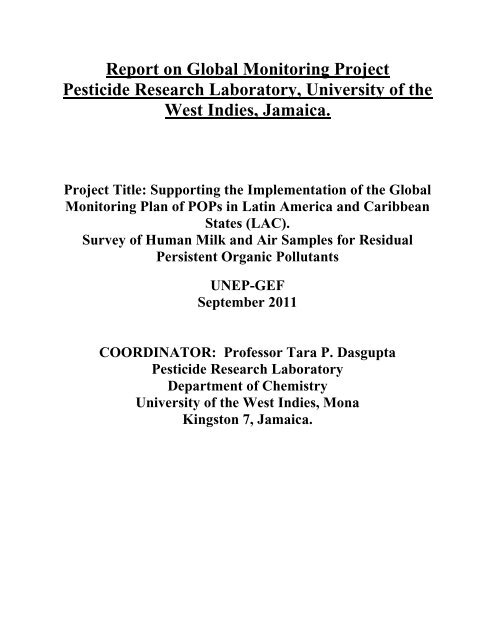


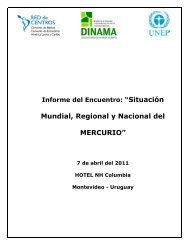
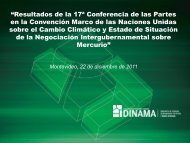

![COP_aire [Compatibility Mode] - Centro Coordinador de Basilea ...](https://img.yumpu.com/44106171/1/190x134/cop-aire-compatibility-mode-centro-coordinador-de-basilea-.jpg?quality=85)
